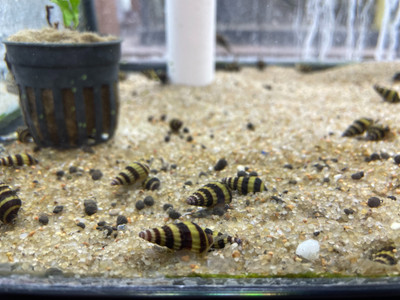Assassin snails
Posted by Max G. on on 12th Aug 2022
It’s been two weeks, you’ve set up your dry scape everything looks great and you’re ready to flood the tank. Suddenly only a few days later you notice pest snails all over the plants and walls. After all this hard work you are now faced with a situation of frustration and uncertainty, are these pest snails going to multiply beyond control? Will this be an issue for my newly set up tank? The short answer is yes, luckily there is a hero ready to save the day!
“Anentome helena” better known as the assassin snail (aka bumblebee snail ) is just the right tool for the job. An interesting snail in the clade Neogastropoda, snails in this order are known to be exclusively carnivorous. A. Helena being uniquely one of the only freshwater variety, it grows to just over an inch. The assassin snail will seek out, kill and eat snails like pest snails as well as others much larger in size! How do they do this? The assassin snail is equipped with unique tools to assist in their venture, let’s break down their anatomy.
Similar to many other carnivorous snails the assassin has a cone shaped shell, a “siphon” tube comes out from the shell which they use to breathe like a snorkel when buried under substrate. These snails do not breathe air and therefore healthy substrate and water parameters are important. Their body structure contains an “operculum” also known as a trapdoor which helps them stay safe when in danger. They will hide within the shell with the operculum as a “door” for protection. Eyes with semi retractable tentacles and a muscular foot are used to move, burrow, hold prey and are important aspects of their mobility. Finally their “weapon” is a structure known as a proboscis, with this hand like tube they roam the tank in search of prey. The proboscis has the ability to pierce into its prey and is even used to open trapdoors ( operculum ) of other snails! Once inside of its prey they effectively suck the life out of their target.
Though they do not attack their own, they will work together to attack much larger snails covering their prey in groups. Also effective scavengers they will eat any dying or decomposing fish laying on the floor. In short no snail is safe around an assassin snail, for serious pest problems a group of 5+ is suggested. After adding several assassin snails to your tank you will see an improvement of your pest issues, as well as have a beautiful new invert addition creating a natural and effective tank maintenance tool.

